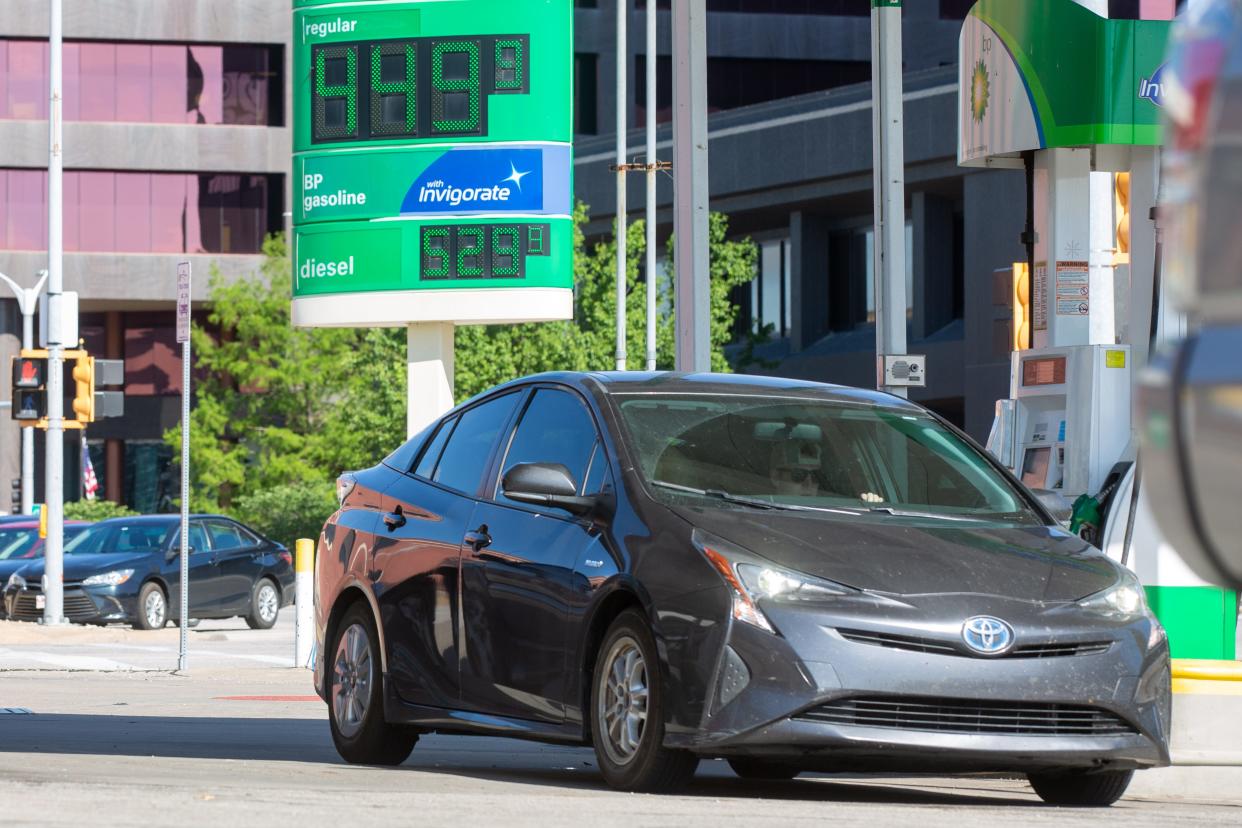Here's how rising gas prices have affected Kansans' lives — and 4 ways to save money

Gasoline prices continue to rise, setting a new record almost every day.
The national average price for regular unleaded gas Monday was $4.865, up from $4.848 the previous day and $4.619 a week earlier, according to AAA.
The average price for regular unleaded in Kansas on Monday was $4.431, compared to $4.418 the previous day and $4.128 a week earlier, it said.
Here's how the increase has affected the daily lives of five readers of The Topeka Capital-Journal's Facebook page, all of whom live in Kansas. Each told about their experiences when asked on The Capital-Journal's Facebook page.
Here's what Kansans are saying about gas prices
Mike LaBonte had planned to travel in his retirement, but rising gas prices are interfering with that.
"Had plans to travel, now you just plan how to survive," said LaBonte, a retired Lawrence man. "Forget anything extra. All so needless."
Topekan Lee Hartman, editor and publisher of Metro Voice News, said higher gas prices have doubled driving costs for his distribution company, which delivers newspapers and magazines all over eastern Kansas.
"That also means our bottom line takes a big hit," he said. "This means less income for me personally, as well as the hit to my personal driving costs. This means I have less money to spend on other things I would normally spend money on."
The higher cost of gas also means cutting back on personal travel, Hartman said.
Osawatomie resident Ron Hohenstein said the effect of rising gas prices has been "not so bad" for Hohenstein and his wife because "it has made us smarter."
Hohenstein said he's learned to combine trips, take advantage of places that deliver, dine out less and drive his wife's higher-mileage car instead of his pickup truck.
"Normally on the highway I set the cruise control 5 mph over the limit," he said. "Now I set it 10 mph under. Makes a difference."
More: Ukrainian agriculture expert taking refuge in Kansas says worst to come for world food supply
Justin Williams, of Lyndon, said rising gasoline costs for his 60-mile round trip commute to Topeka will probably cause him to cut his lunch budget.
Williams usually spends $12 to $15 per day to eat out at locally owned restaurants in Topeka.
"Now, I’ll probably resort to eating sandwiches or skipping lunch," he said.
Alex Zerbe, a native of Topeka and resident of Osage County's Quenemo community, says he has found himself spending $400 to $500 a week on fuel.
Zerbe, 58, owns a remodeling and building materials business, Z Home Restoration.
"It's simple," he said. "This sucks."
How can I save gas while driving?
Checking tire pressure is especially important for boosting fuel economy while driving, AAA spokesperson Ellen Edmonds told USA Today.
This can be done at home with a tire gauge or at a gas station. It prevents underinflation, which can cause drivers to lose 5% of their fuel economy, according to Edmonds.
“(That) doesn't sound like a lot, but when gas prices are over $4, it definitely will make a difference,” she said.
What is the most gas-efficient way to drive?
Drivers can take additional steps to boost fuel economy.
Speeding and rapidly accelerating or braking can lower gas mileage by 15% to 30% at highway speeds or up to 40% in stop-and-go traffic, according to the U.S. Department of energy.
Edmonds suggests planning routes and drive times that avoid major congestion to keep speeds steady.
More: Drought conditions across much of Kansas could cost wheat farmers more than $1 billion
Idling — another product of heavy traffic — can waste up to a half-gallon of fuel per hour, according to the Department of Energy. Edmonds said drivers can save fuel by temporarily turning their car off if standstill traffic lasts more than 10 seconds.
“That actually uses less gas than if you're just sitting and idling for several minutes,” Edmonds said.
Is it more fuel-efficient to drive fast or slow?
Fuel-efficient speeds are typically capped at 50 mph miles per hour, with each additional 5 mph miles per hour equivalent to paying an extra 29 cents per gallon of gas, according to the Department of Energy. Drivers can flip on their cruise control to keep speeds — and costs — lower, or opt for slower, more scenic routes.
“A road trip is as much about the journey as it is about getting to the destination,” Edmonds said. "If you can stay in that (50 mph miles per hour) sweet spot and stay consistent, that can improve your fuel economy."
Removing weight can also help fuel efficiency, especially when driving a smaller vehicle.
A large rooftop cargo box can reduce fuel economy up to 25% at interstate speeds, and an extra 100 pounds in the trunk can reduce miles per gallon by 1%, according to the Department of Energy.
How to find the lowest gas prices
Making a pit stop at the first available gas station may be tempting, but Patrick De Haan, head of petroleum analysis at fuel-savings app GasBuddy, told USA Today it’s worth shopping around before filling up your tank.
This is especially true for motorists crossing state lines, which De Haan labeled “danger zones” for drivers.
“Every state has various gas taxes,” he said. “You may be either leaving the cheap fuel behind, or the cheaper fuel may be in front of you.”
Tim Hrenchir can be reached at threnchir@gannett.com or 785-213-5934. Bailey Schulz of USA TODAY contributed to this report.
This article originally appeared on Topeka Capital-Journal: Here's how record-setting gas prices are affecting lives of 5 Kansans

